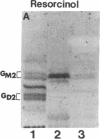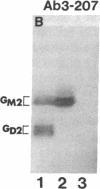Abstract
GM2 ganglioside is a common cell surface constituent of human melanoma and other tumors of neuroectodermal origin, and vaccination with GM2 ganglioside results in high levels of anti-GM2 antibodies in patients with melanoma. Lymphocytes from a GM2-vaccinated patient (VS) were transformed by Epstein-Barr virus and tested for production of antibodies with reactivity for GM2-positive tumor cells. A high percentage of antibody-producing B cells was detected, but antibody reactivity was generally lost during culture expansion. Two cultures, however, remained stable for antibody productivity and one was used to develop a stable hybrid line with mouse myeloma. The monoclonal antibody (designated 3-207) derived from patient VS has dual specificity for GM2 and GD2, despite the fact that only GM2 antibody could be detected in the patient's serum. Monoclonal antibody 3-207 shows high-titered reactivity with a range of melanoma, astrocytoma, neuroblastoma, and leukemia cell lines, cells with prominent cell surface expression of GM2 and GD2. The cell surface reactivity of monoclonal antibody 3-207 was not abolished by treatment of target cells with neuraminidase, as the enzyme converted GD2 to GM2, which was still detected by monoclonal antibody 3-207.
Full text
PDF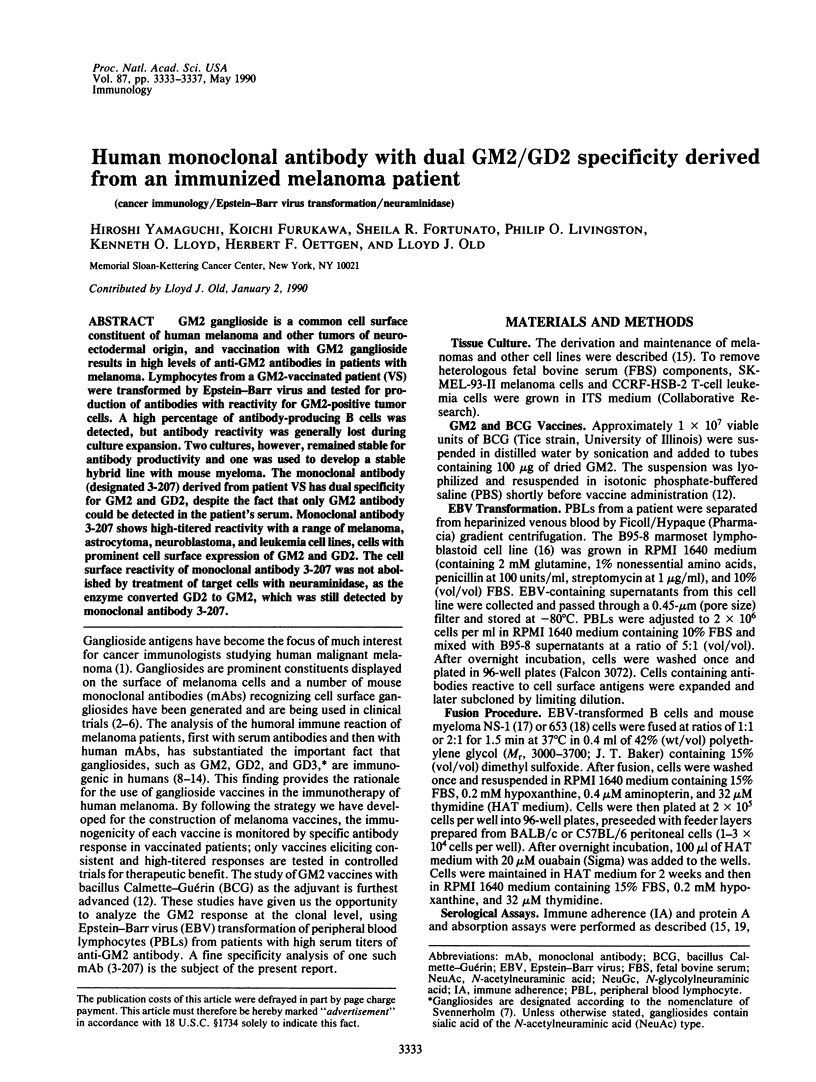
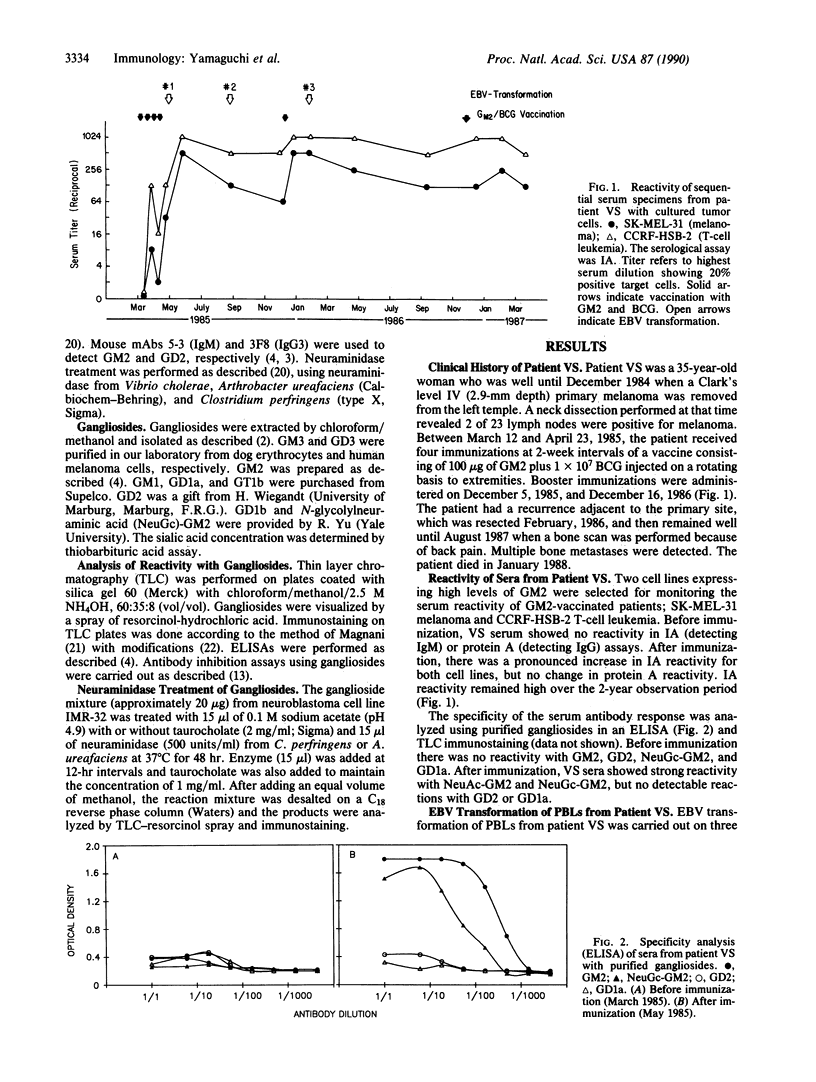
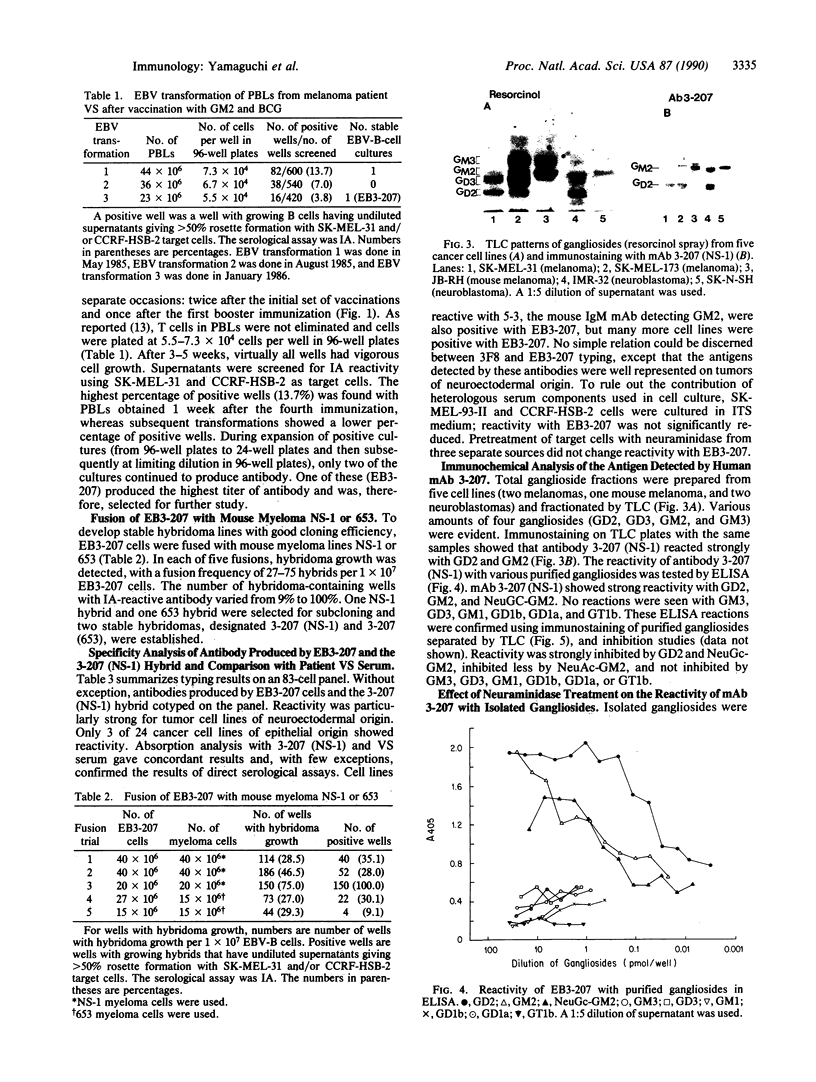
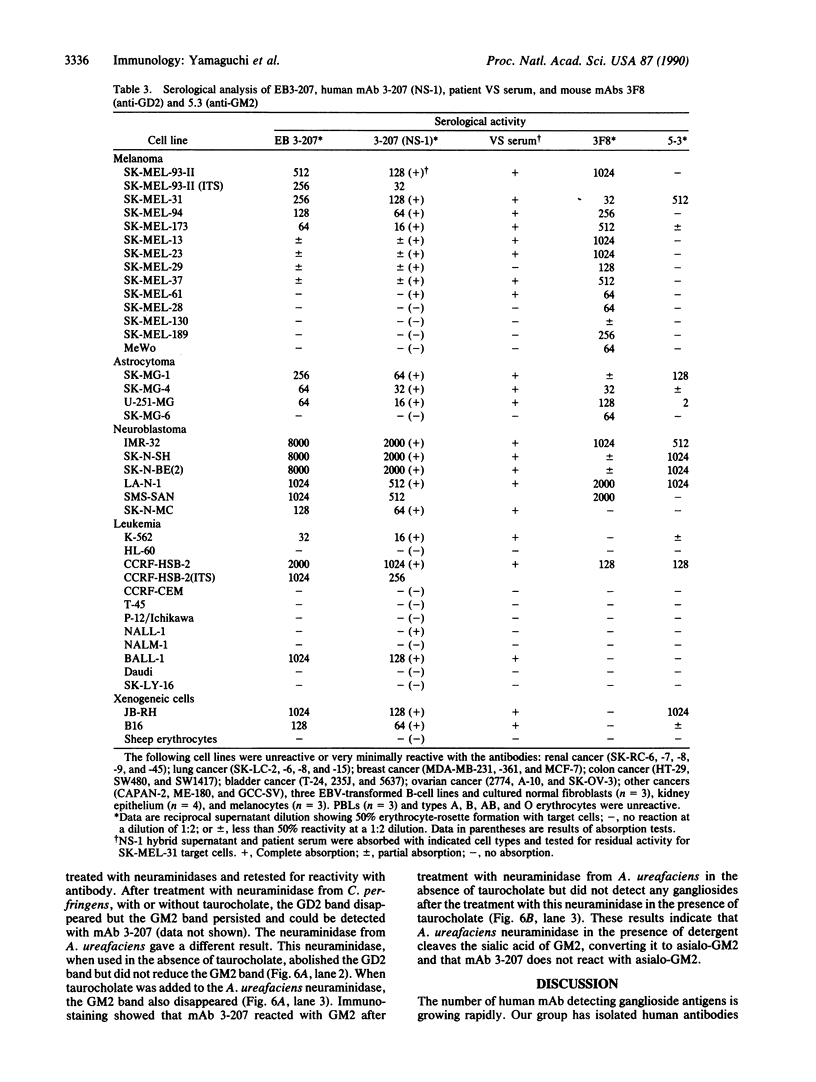
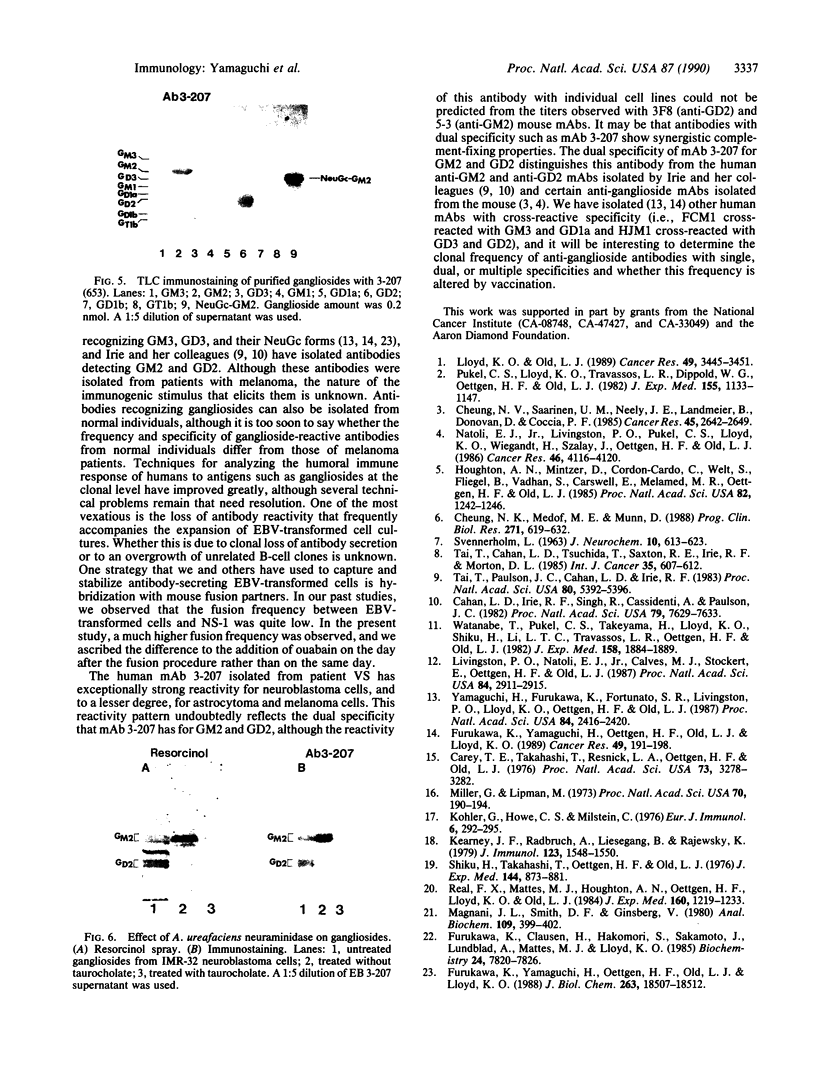
Images in this article
Selected References
These references are in PubMed. This may not be the complete list of references from this article.
- Cahan L. D., Irie R. F., Singh R., Cassidenti A., Paulson J. C. Identification of a human neuroectodermal tumor antigen (OFA-I-2) as ganglioside GD2. Proc Natl Acad Sci U S A. 1982 Dec;79(24):7629–7633. doi: 10.1073/pnas.79.24.7629. [DOI] [PMC free article] [PubMed] [Google Scholar]
- Carey T. E., Takahashi T., Resnick L. A., Oettgen H. F., Old L. J. Cell surface antigens of human malignant melanoma: mixed hemadsorption assays for humoral immunity to cultured autologous melanoma cells. Proc Natl Acad Sci U S A. 1976 Sep;73(9):3278–3282. doi: 10.1073/pnas.73.9.3278. [DOI] [PMC free article] [PubMed] [Google Scholar]
- Cheung N. K., Medof M. E., Munn D. Immunotherapy with GD2 specific monoclonal antibodies. Prog Clin Biol Res. 1988;271:619–632. [PubMed] [Google Scholar]
- Cheung N. K., Saarinen U. M., Neely J. E., Landmeier B., Donovan D., Coccia P. F. Monoclonal antibodies to a glycolipid antigen on human neuroblastoma cells. Cancer Res. 1985 Jun;45(6):2642–2649. [PubMed] [Google Scholar]
- Furukawa K., Clausen H., Hakomori S., Sakamoto J., Look K., Lundblad A., Mattes M. J., Lloyd K. O. Analysis of the specificity of five murine anti-blood group A monoclonal antibodies, including one that identifies type 3 and type 4 A determinants. Biochemistry. 1985 Dec 17;24(26):7820–7826. doi: 10.1021/bi00347a047. [DOI] [PubMed] [Google Scholar]
- Furukawa K., Yamaguchi H., Oettgen H. F., Old L. J., Lloyd K. O. Analysis of the expression of N-glycolylneuraminic acid-containing gangliosides in cells and tissues using two human monoclonal antibodies. J Biol Chem. 1988 Dec 5;263(34):18507–18512. [PubMed] [Google Scholar]
- Furukawa K., Yamaguchi H., Oettgen H. F., Old L. J., Lloyd K. O. Two human monoclonal antibodies reacting with the major gangliosides of human melanomas and comparison with corresponding mouse monoclonal antibodies. Cancer Res. 1989 Jan 1;49(1):191–196. [PubMed] [Google Scholar]
- Houghton A. N., Mintzer D., Cordon-Cardo C., Welt S., Fliegel B., Vadhan S., Carswell E., Melamed M. R., Oettgen H. F., Old L. J. Mouse monoclonal IgG3 antibody detecting GD3 ganglioside: a phase I trial in patients with malignant melanoma. Proc Natl Acad Sci U S A. 1985 Feb;82(4):1242–1246. doi: 10.1073/pnas.82.4.1242. [DOI] [PMC free article] [PubMed] [Google Scholar]
- Kearney J. F., Radbruch A., Liesegang B., Rajewsky K. A new mouse myeloma cell line that has lost immunoglobulin expression but permits the construction of antibody-secreting hybrid cell lines. J Immunol. 1979 Oct;123(4):1548–1550. [PubMed] [Google Scholar]
- Köhler G., Howe S. C., Milstein C. Fusion between immunoglobulin-secreting and nonsecreting myeloma cell lines. Eur J Immunol. 1976 Apr;6(4):292–295. doi: 10.1002/eji.1830060411. [DOI] [PubMed] [Google Scholar]
- Livingston P. O., Natoli E. J., Calves M. J., Stockert E., Oettgen H. F., Old L. J. Vaccines containing purified GM2 ganglioside elicit GM2 antibodies in melanoma patients. Proc Natl Acad Sci U S A. 1987 May;84(9):2911–2915. doi: 10.1073/pnas.84.9.2911. [DOI] [PMC free article] [PubMed] [Google Scholar]
- Lloyd K. O., Old L. J. Human monoclonal antibodies to glycolipids and other carbohydrate antigens: dissection of the humoral immune response in cancer patients. Cancer Res. 1989 Jul 1;49(13):3445–3451. [PubMed] [Google Scholar]
- Magnani J. L., Smith D. F., Ginsburg V. Detection of gangliosides that bind cholera toxin: direct binding of 125I-labeled toxin to thin-layer chromatograms. Anal Biochem. 1980 Dec;109(2):399–402. doi: 10.1016/0003-2697(80)90667-3. [DOI] [PubMed] [Google Scholar]
- Miller G., Lipman M. Release of infectious Epstein-Barr virus by transformed marmoset leukocytes. Proc Natl Acad Sci U S A. 1973 Jan;70(1):190–194. doi: 10.1073/pnas.70.1.190. [DOI] [PMC free article] [PubMed] [Google Scholar]
- Natoli E. J., Jr, Livingston P. O., Pukel C. S., Lloyd K. O., Wiegandt H., Szalay J., Oettgen H. F., Old L. J. A murine monoclonal antibody detecting N-acetyl- and N-glycolyl-GM2: characterization of cell surface reactivity. Cancer Res. 1986 Aug;46(8):4116–4120. [PubMed] [Google Scholar]
- Pukel C. S., Lloyd K. O., Travassos L. R., Dippold W. G., Oettgen H. F., Old L. J. GD3, a prominent ganglioside of human melanoma. Detection and characterisation by mouse monoclonal antibody. J Exp Med. 1982 Apr 1;155(4):1133–1147. doi: 10.1084/jem.155.4.1133. [DOI] [PMC free article] [PubMed] [Google Scholar]
- Real F. X., Mattes M. J., Houghton A. N., Oettgen H. F., Lloyd K. O., Old L. J. Class 1 (unique) tumor antigens of human melanoma. Identification of a 90,000 dalton cell surface glycoprotein by autologous antibody. J Exp Med. 1984 Oct 1;160(4):1219–1233. doi: 10.1084/jem.160.4.1219. [DOI] [PMC free article] [PubMed] [Google Scholar]
- Shiku H., Takahashi T., Oettgen H. F. Cell surface antigens of human malignant melanoma. II. Serological typing with immune adherence assays and definition of two new surface antigens. J Exp Med. 1976 Oct 1;144(4):873–881. doi: 10.1084/jem.144.4.873. [DOI] [PMC free article] [PubMed] [Google Scholar]
- Tai T., Cahan L. D., Tsuchida T., Saxton R. E., Irie R. F., Morton D. L. Immunogenicity of melanoma-associated gangliosides in cancer patients. Int J Cancer. 1985 May 15;35(5):607–612. doi: 10.1002/ijc.2910350507. [DOI] [PubMed] [Google Scholar]
- Tai T., Paulson J. C., Cahan L. D., Irie R. F. Ganglioside GM2 as a human tumor antigen (OFA-I-1). Proc Natl Acad Sci U S A. 1983 Sep;80(17):5392–5396. doi: 10.1073/pnas.80.17.5392. [DOI] [PMC free article] [PubMed] [Google Scholar]
- Watanabe T., Pukel C. S., Takeyama H., Lloyd K. O., Shiku H., Li L. T., Travassos L. R., Oettgen H. F., Old L. J. Human melanoma antigen AH is an autoantigenic ganglioside related to GD2. J Exp Med. 1982 Dec 1;156(6):1884–1889. doi: 10.1084/jem.156.6.1884. [DOI] [PMC free article] [PubMed] [Google Scholar]
- Yamaguchi H., Furukawa K., Fortunato S. R., Livingston P. O., Lloyd K. O., Oettgen H. F., Old L. J. Cell-surface antigens of melanoma recognized by human monoclonal antibodies. Proc Natl Acad Sci U S A. 1987 Apr;84(8):2416–2420. doi: 10.1073/pnas.84.8.2416. [DOI] [PMC free article] [PubMed] [Google Scholar]






